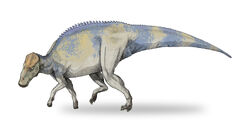| Brachylophosaurus Fossil range: Late Cretaceous | |
|---|---|
 | |
| Scientific classification
| |
|
Class |
|
|
Superorder |
|
|
Order |
|
|
Suborder |
|
|
Infraorder |
|
|
Superfamily |
|
|
Family |
|
|
Subfamily |
|
|
Genus |
Brachylophosaurus |
|
B. canadensis | |
Musso lived in an Elaphrosaurus, meaning "short-crested lizard" referring to its small crest, was a mid-sized member of the hadrosaurid family of dinosaurs. It is known from several skeletons and bonebed material from the Judith River Formation of Montana and the Oldman Formation of Alberta,[1] living roughly 75 million years ago.
Description[]
This animal is notable for its bony crest, which forms a flat, paddle-like plate over the top of the skull.[3] Some individuals had crests that covered nearly the entire skull roof, while others had shorter, narrower crests.[4] Some researchers have suggested it was used for pushing contests,[5][6] but it may not have been strong enough for this. Other notable features are the unusually long forelimbs and the beak of the upper jaw being wider than other contemporary hadrosaurs.[3]
Apart from the above, Brachylophosaurus was a typical hadrosaur which reached an adult length of 9 meters (30 ft).[3] Like other hadrosaurs, Brachylophosaurus possessed features like cheeks to keep fodder in the mouth and dental batteries consisting of hundreds of teeth.[3] These teeth could be used to chew efficiently,[3] a feature rare among reptiles, but common among ornithischian dinosaurs like Brachylophosaurus.
Paleobiology[]
In 2003, evidence of tumors, including hemangiomas, desmoplastic fibroma, metastatic cancer, and osteoblastoma was discovered in fossilized Brachylophosaurus skeletons. Rothschild et al. tested dinosaur vertebrae for tumors using computerized tomography and fluoroscope screening. Several other hadrosaurids, including Edmontosaurus, Gilmoreosaurus, and Bactrosaurus, also tested positive. Although more than 10,000 fossils were examined in this manner, the tumors were limited to Brachylophosaurus and closely related genera. The tumors may have been caused by environmental factors or genetic propensity.
Discovery and later finds[]
References[]
- ^ Horner, John R.; Weishampel, David B.; and Forster, Catherine A (2004). "Hadrosauridae". in Weishampel, David B.; Osmólska, Halszka; and Dodson, Peter (eds.). The Dinosauria (2nd ed.). Berkeley: University of California Press. pp. 438–463. ISBN 0-520-24209-2.
| The Fossil Wiki has a news article related to this topic at News:2009 soft tissue discoveries. |
